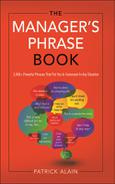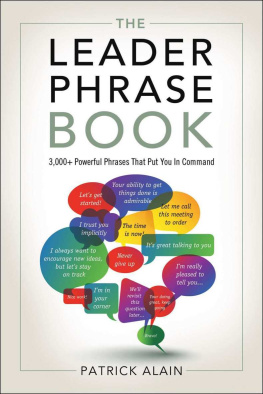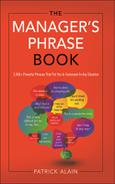First of all, I would like to express gratitude to Bassam and Lina Abi-Samra and profound appreciation to my magnificent wife, Zaina, for their unwavering support during the year it took me to write this book. Next, I would be remiss if I did not thank my mother, Jacqueline, for all of her sacrifices.
I would also like to give special appreciation to Tom Carroll and Yesha Raval for their extraordinary contributions to the creativity represented in this work.
I would also like to give special appreciation to Tom Carroll and Yesha Raval for their extraordinary contributions to the creativity represented in this work.
With deepest thanks I also recognize my agent, Jessica Faust; my developmental editor, Kirsten Dalley; and my publicist, Tess Woods. Without these people, who were so generous with their time, commitment, and energy, this book would never have been possible.
Preface
Are you a purchasing manager, a production manager, or an IT manager? Do you manage in marketing, sales, or finance? Is it up to you to take charge of human resources or product development? Regardless of your industry or level of experience, you have to make optimum use of all the resources you have at your disposal. Being thrust into an unpredictable situation can be difficult, and this is doubly true when you are a manager. Regardless of whether you are a seasoned manager or someone who has not yet experienced all the power, perils, and pitfalls of leading people, you will be expected to take charge and make things better for your direct reports and the company. This balancing act isnt always easy, and it can be especially stressful if you are fumbling for words or lacking in nuance in your communications.
The fact that you reached for this book means that you probably arent satisfied with how youve been handling this aspect of your job. You know you can do better, but you need some magic phrases to help kick-start the process. And because youre busy, you need a reference tool that is concise, easy to use, and portable. In this book youll find hundreds of specific responses that have helped managers and would-be managers just like you take control of their communications. My goal in writing this book was to share these talking points so that you can develop a strong and capable managerial presence in any situation. The higher up you move in the chain of command, the more readily you will need to be able to summon powerful and effective words and phrasesto motivate, to inspire, to correct, to command.
Ideally they should become second nature, a part of your everyday routine. To help you do that, this book is organized into 10 easy-to-digest sections, plus one bonus section at the end. There is also a comprehensive index at the end to help you locate relevant topics easily. The fact is, no matter how successful or seasoned you are as a manageror even if youve never managed before in your lifechances are your communication skills could use some polishing. This invaluable tool will enhance your command of the idiom and allow your confidence and managerial skills to shine through. You will find it incredibly rewarding, both personally and professionally, as you learn to speak boldly, persuasively, and, perhaps most of all, appropriately in any situation.
Let our journey to managerial confidence begin!
How to Use This Book
This book was designed with flexibility in mind. You can read it all the way through to get a general overview, or you can work on one particular situation or aspect of communication that you find the most challenging or relevant. For example, you may feel very comfortable talking to an employee about a personal problem, but you may not feel as relaxed when doling out criticism. Use the in-depth Index at the back to help you find the topic that is most applicable to your situation. Read all the sample phrases and make a point to familiarize yourself with the ones that seem the most natural or comfortable for you. Then practice them until they flow naturally from your mouth.
When the time comes youll have no trouble summoning them and using them with confidence and aplomb. And because everyone says things in a slightly different way, theres a bit of space in the margins where you can add your own favorite catch phrases. The right words are not enough, however. Remember that tone, body language, and timing (context) are all important in conveying meaning and in how your statements are perceived by others. Thus, a humorous phrase that would be effective and appropriate in one setting could be construed as hostile and inappropriate in another, depending on how, when, and to whom it is said. Use good judgment and let context be your guide.
This is particularly important when you are considering using humor or sarcasm to make a point. Humor can sometimes come across as flip or dismissive, and sarcasm is definitely one of the quickest ways to make someone feel inept. Not everyone will appreciate your style of delivery, so nuance is always required.
Conciliatory
The indicator accompanying each situation will help you anchor each order of magnitude in your mind, which will serve as a valuable mnemonic device down the road. For example, in the sample to the left, the continuum indicator goes from
Conciliatory to
Argumentative. All of the phrases in this book are presented on a similar scale.













 Copyright 2013 by The Live Shot, Inc. All rights reserved under the Pan-American and International Copyright Conventions. This book may not be reproduced, in whole or in part, in any form or by any means electronic or mechanical, including photocopying, recording, or by any information storage and retrieval system now known or hereafter invented, without written permission from the publisher, The Career Press. THE MANAGERS PHRASE BOOK EDITED BY KIRSTEN DALLEY TYPESET BY DIANA GHAZZAWI Cover design by Jeff Piasky Printed in the U.S.A. To order this title, please call toll-free 1-800-CAREER-1 (NJ and Canada: 201-848-0310) to order using VISA or MasterCard, or for further information on books from Career Press. 220 West Parkway, Unit 12 Pompton Plains, NJ 07444 www.careerpress.com
Copyright 2013 by The Live Shot, Inc. All rights reserved under the Pan-American and International Copyright Conventions. This book may not be reproduced, in whole or in part, in any form or by any means electronic or mechanical, including photocopying, recording, or by any information storage and retrieval system now known or hereafter invented, without written permission from the publisher, The Career Press. THE MANAGERS PHRASE BOOK EDITED BY KIRSTEN DALLEY TYPESET BY DIANA GHAZZAWI Cover design by Jeff Piasky Printed in the U.S.A. To order this title, please call toll-free 1-800-CAREER-1 (NJ and Canada: 201-848-0310) to order using VISA or MasterCard, or for further information on books from Career Press. 220 West Parkway, Unit 12 Pompton Plains, NJ 07444 www.careerpress.com Library of Congress Cataloging-in-Publication Data Alain, Patrick. 220 West Parkway, Unit 12 Pompton Plains, NJ 07444 www.careerpress.com
Library of Congress Cataloging-in-Publication Data Alain, Patrick. 220 West Parkway, Unit 12 Pompton Plains, NJ 07444 www.careerpress.com